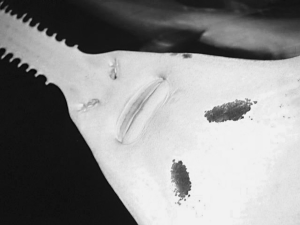
Reprinted with Permission – MOTE News Magazine, Fall 2003
Jules Verne would be hard-pressed to create such an intriguing, yet awkward-looking creature. With its shark body, nearly flat underside and hedge trimmer-looking nose, the sawfish evokes feelings of adventure and mystery. But like Verne’s Nautilus submarine in “20,000 Leagues Under the Sea,” this mysterious creature is in danger of disappearing forever.

Simpfendorfer attaches a plastic streamer tag to a small-tooth sawfish. This is the kind of tag fishermen are most likely to encounter. When turned in by fishermen with information, the tag helps scientists understand the movements and growth rates of individuals.
Different Time, Different Place
There was a time when seeing a sawfish was as easy as peeking over a dock into almost any of the coastal waters around Florida. In the late 1800s, there were hundreds of thousands of sawfish and they could be found as far north as New York.
“It wasn’t difficult to see a sawfish in the wild back then,” said Dr. Colin Simpfendorfer, senior scientist with Mote’s Center for Shark Research. But as a result of gill netting, trawling and coastal development, the animal has been all but wiped out from most of its range. According to many scientists, the sawfish population has declined as much as 95%.
“Today we estimate there may be only a couple of thousand left in the wild,” Simpfendorfer said.
A Step in the Right Direction
Responding to the alarming decline in sawfish numbers, Mote Marine Laboratory’s Center for Shark Research started the Sawfish Conservation Biology Research Project in 1999 to provide scientific data about one of the most endangered of the seven species in the sawfish family — the smalltooth sawfish.
“Our research is a positive step towards conserving these unique, and now rare, creatures,” said Simpfendorfer.
Simpfendorfer’s research tools and techniques would dazzle even the likes of Jules Verne. Using a combination of satellite telemetry, satellite tracking and acoustic monitoring, along with old-fashioned eyewitness accounts, Mote researchers collected considerable information to get the sawfish listed as an endangered species.
“When we stepped up to do this research, a number of people said we were crazy,” Simpfendorfer said. “They said there weren’t enough of these animals left to do anything with. We proved them wrong.”

Smalltooth sawfish use their hedge-trimmer like saw to slash fish and kill them. Then the sawfish sucks prey into its mouth with the vacuum-like effect created when it opens its mouth.
Take one look at the smalltooth sawfish (Pristis pectinata) and it’s easy to see why the animal fascinates even an experienced scientist like Simpfendorfer. Sawfish are the world’s second-largest rays, closely related to sharks and skates. They can range from just a few feet to more than 20 feet long and weigh as much as 2000 pounds. Sawfish get their name from the long, flattened “saw” rimmed by dozens of “teeth” that protrudes forward from the front of their heads.
The sawfish uses its saw to hunt, slashing through schools of fish, killing and injuring them, then sucking the prey into their mouths. That same “saw” has also contributed to the animals’ decline because it is easily caught in fishing nets, proving fatal for many animals.
“Sawfish became bycatch,” when the saw got caught in the net and the animal was killed to prevent damage to equipment, explained Simpfendorfer.
In 1999, the Ocean Conservancy petitioned to have the smalltooth sawfish listed as an endangered species. Mote’s research was sent to the National Marine Fisheries Service, which is charged with reviewing the data and making a determination. Getting an animal on the endangered species list is no walk on the beach, but in the end, political currents flowed in favor of the sawfish.
On April 1, 2003 the smalltooth sawfish was officially added to the list — the first listing for a marine fish in U.S. waters.
Improving the Outlook
Now that the smalltooth sawfish is a federally protected species, it is illegal to keep one if caught.
Since being listed on the endangered species list, the sawfish’s status is already improving, Simpfendorfer said. “While the animal is still very much endangered, we believe that the decline has slowed. The challenge now is increasing the numbers so that another kill off doesn’t wipe it out completely.”
You’ve got mail!
A gray egg-shaped satellite tag is just visible on the sawfish at right. After several months, the tag is programmed to pop off and transmit the data it collected to a satellite. The satellite then transmits the data to an earth station that sends Mote scientists an e-mail.
HELP SAWFISH CONSERVATION & RESEARCH
If you catch a sawfish or see one, please report it. Call: 800-691-MOTE (6683) or e-mail: sawfish@mote.org.
Mote set up a hotline to record sawfish reports in 2000.
Since then, about 400 have been sighted. The information helps researchers fill in data about where the sawfish are still living. “It’s added more detail to the distribution within the range we already knew about,” said Colin Simpfendorfer, Mote senior scientist.
When making a report, please include:
- Name and contact information
- Date, time and location of encounter
- Approximate size of sawfish
- Your activity during the encounter
(fishing, diving, etc.) - Photos or video if available

